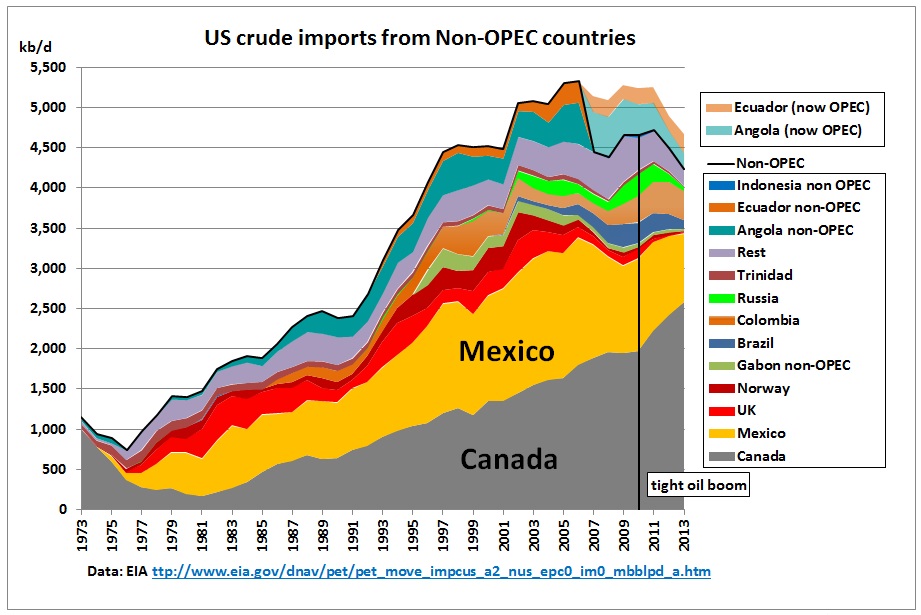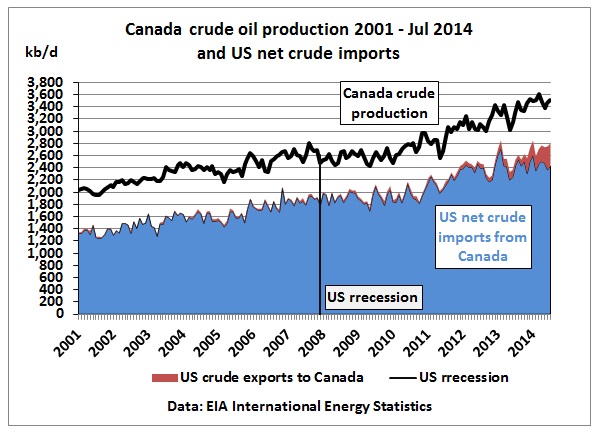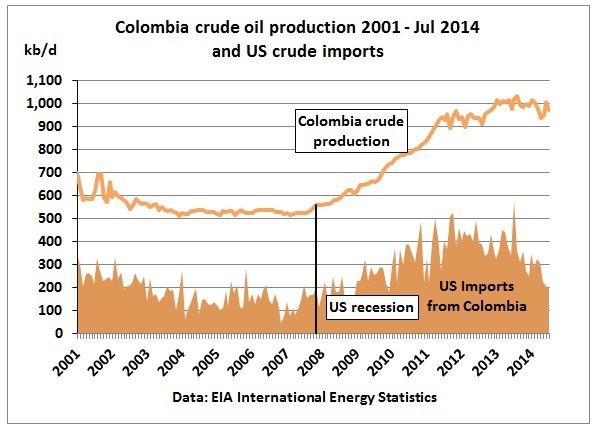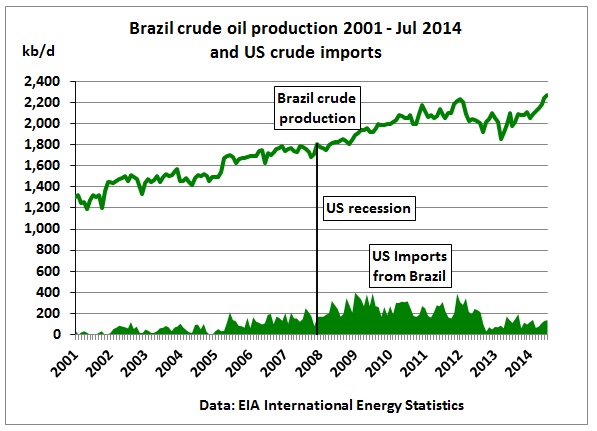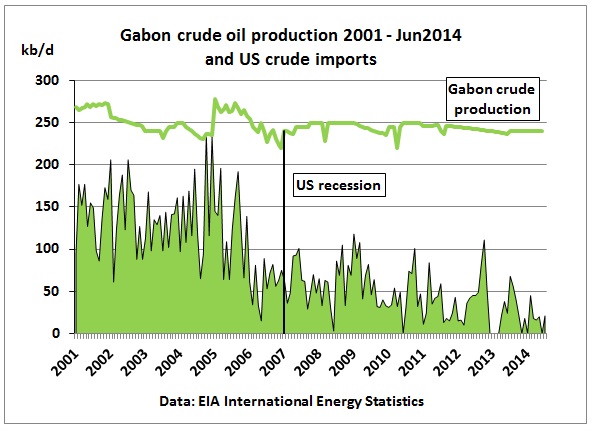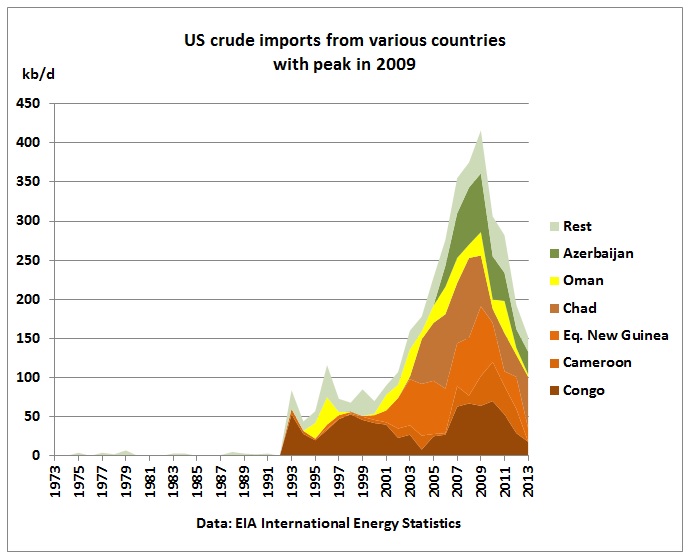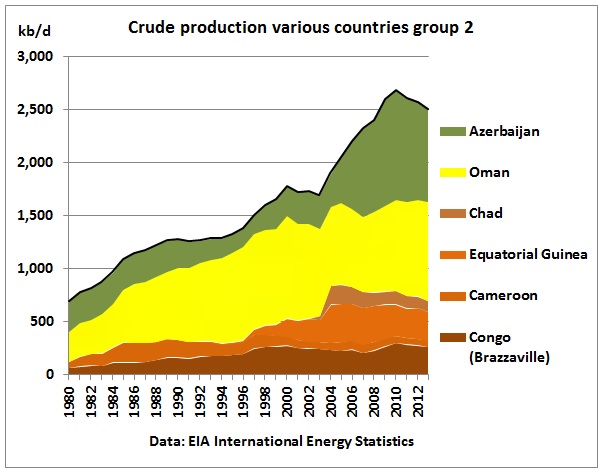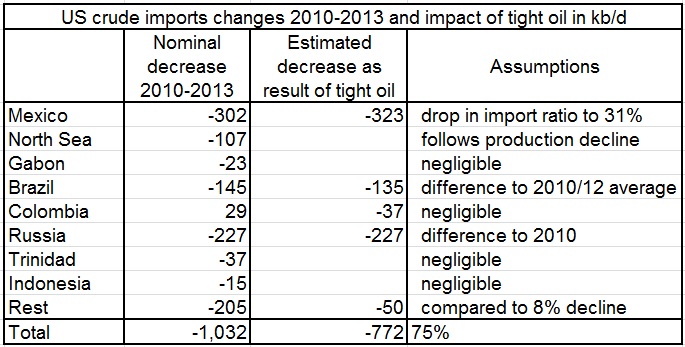In part 3 of this series on the impact of US tight oil, we look at US crude oil imports from Non-OPEC countries. Excluding Canada – which is a special case due to its integration into the North American oil market – these imports peaked in 2002, long before the tight oil boom started.
Part 1, Part 2
(1) Introduction: US oil imports from Non-OPEC countries
The following graph shows an overview on US oil imports (crude + products) since 1960
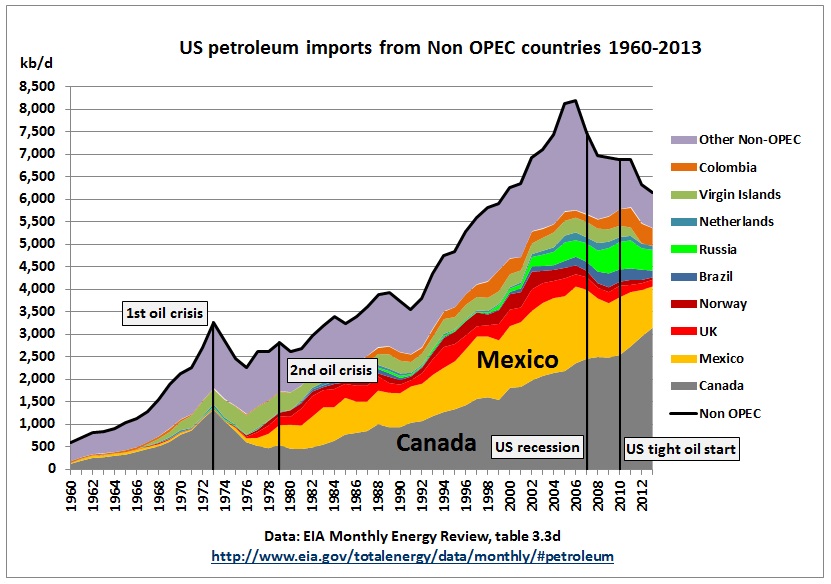
Fig 1: US oil imports from Non-OPEC countries
Imports peaked in 2005/06. The subsequent decline until 2010 was caused by high oil prices and the financial crisis.
The speed of the decline was similar to the period following the 1st oil crisis. The tight oil boom started in 2010/11, causing a further decrease of around 750 kb/d.
(2) US crude oil imports from Non-OPEC countries
Fig 2: US crude oil imports from Non-OPEC countries
Data are from the EIA, starting in 1973
US crude imports from Non-OPEC countries dropped sharply in 2007 by around 1 mb/d when Angola and Ecuador joined OPEC. The graph shows that including these 2 countries imports continued on the same level until 2011 after which imports really declined by about 500 kb/d. The dominance of Canada is clearly visible.
(3) US crude imports from Canada
Fig 3: US net crude imports vs Canadian crude production
Fig 3 shows that US crude imports from Canada pretty much follow growing Canadian crude production, at levels around 700 kb/d lower. The impact of US tight oil can be seen in US crude exports (dark red area) increasing above long-term averages since 2013, reaching 360 kb/d by mid 2014.
Canadian crude production growth is entirely driven by tar-sands:
Fig 4: Canadian crude oil production by type of oil
This is not good news for the climate:
Tar sands make climate change ‘unsolvable’: Hansen
“The potential amount of carbon in these unconventional resources is huge,” Hansen told the Environmental Audit Committee. “If we introduce the tar shale and the tar sands as a source and exploit those resources to a significant extent, then the problem becomes unsolvable.”
(4) US crude imports from Mexico
Fig 5: US net crude imports vs Mexican crude production
Just like with Canada, US crude imports from Mexico basically follow Mexico’s crude production which peaked in 2003/04, declined but then stabilized since 2010. US imports peaked in 2006 and then also declined. The long-term ratio of US imports to Mexican production was 44% but it dropped to 31% in the 1st half of 2014. This difference of 320 kb/d could be attributed to tight oil. There were no US crude exports to Mexico.
(5) US crude imports from North Sea
Fig 6: US net crude imports vs North Sea crude production
US crude imports from the North See followed its decline.
(6) US crude imports from Colombia
Fig 7: US crude imports from Colombia
US crude imports from Colombia dropped by 100 kb/d after 2011, but the difference between 2010 and 2013 is negligible.
(7) US crude imports from Brazil
Fig 8: US crude imports from Brazil
US crude imports from Brazil dropped when Brazilian crude production started a decline phase in 2012. At best, tight oil caused a drop of 135 Kb/d of US oil imports.
(8) US crude imports from Russia
Fig 9: US crude imports from Russia
US crude imports from Russia maxed out in 2010 at 270 kb/d and petered out to 40 kb/d in 2014. They are negligible compared to Russian crude production which seems to reach a maximum of around 10 mb/d.
(9) US crude imports from Gabon
Fig 10: US crude imports from Gabon
Gabon’s oil production (light oil) peaked in 1997 at 370 kb/d and declined but has stabilized since 2000. Local consumption is low, with a refinery requiring around 20 kb/d. US crude imports from Gabon started to drop in 2006, long before the tight oil boom. It is mainly Asian countries which benefitted from this, but also Europe. The US import drop attributable to tight oil is negligible.
Fig 11: Gabon crude oil exports
(10) Minor US imports from other countries
There are 2 phases here. One group peaked in 1998, the other in 2009.
Fig 12: US crude imports from various countries peak 1998
Imports from this group of countries peaked already in 1998 and then declined. Most of this decline was before 2007, at the rate of 8 %pa. Using this rate and comparing it with actual imports, a tight oil related drop of imports is estimated at 50 kb/d.
.
 Fig 13: Crude production of countries from Fig 12
Fig 13: Crude production of countries from Fig 12
The graph shows that – excluding China from where US imports have petered out anyway – crude production of the group of countries from Fig 12 has peaked in 2000, incidentally shaped by the Australian peak. After this peak, production declined at 3% pa. So US imports declined more than twice the rate at which production declined, long before the tight oil boom started.
Fig 14: US crude imports from various countries peak 2009
US imports from this group of countries peaked in 2009, the year of the financial crisis, and then declined by 110 kb/d in 1 year or 130 kb/d in 2 years. From 2011 to 2013 there was another 130 kb/d drop. It seems import drops were so steep anyway that tight oil did not make much difference.
Fig 15: Crude production of countries from Fig 14
Production from this group peaked in 2010 and declined by 2% pa.
Summary
Fig 16: US crude imports from Non-OPEC countries excluding Canada
This graph is the same as Fig 2, but without Canada and the Non-OPEC periods of Angola and Ecuador. It shows that US crude imports from these countries peaked around 10 years before the tight oil boom started.
The table shows that around 75% of the decrease in US crude oil imports was caused by the growth in tight oil production. The other 25% would have happened anyway as crude production in the countries of origin have peaked anyway.
In the next post we’ll look at product imports.




